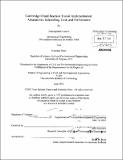| dc.contributor.advisor | John Attanucci. | en_US |
| dc.contributor.author | Iglesias Cuervo, Jesus | en_US |
| dc.contributor.other | Massachusetts Institute of Technology. Dept. of Civil and Environmental Engineering. | en_US |
| dc.coverage.spatial | n-us-ma | en_US |
| dc.date.accessioned | 2012-10-10T15:45:20Z | |
| dc.date.available | 2012-10-10T15:45:20Z | |
| dc.date.copyright | 2012 | en_US |
| dc.date.issued | 2012 | en_US |
| dc.identifier.uri | http://hdl.handle.net/1721.1/73788 | |
| dc.description | Thesis (M. Eng.)--Massachusetts Institute of Technology, Dept. of Civil and Environmental Engineering, 2012. | en_US |
| dc.description | Cataloged from PDF version of thesis. | en_US |
| dc.description | Includes bibliographical references (p. 77). | en_US |
| dc.description.abstract | The Grand Junction railroad lies at the heart of East Cambridge adjacent to the Kendall Square business district and the Massachusetts Institute of Technology campus. Over the last one hundred years the railroad has gone through substantial changes - from an important freight corridor to having just a few train movements per day. The recent purchase of the railroad by the Commonwealth of Massachusetts, planned relocations of existing freight yards, and future corridor improvements have made it possible to consider the addition of passenger services on the Grand Junction. Rising employment, population, and the congestion of the existing commuter rail facilities necessitate exploration of existing means to alleviate capacity. This study is part of larger study that explores the addition of passenger transit services on the Grand Junction with the goal of increasing frequency and capacity to the west along the Worcester/Framingham main line. The topics of this paper are service alternatives, scheduling, cost and performance. The study outlines all possible alternatives that are then screened for final analysis. Commuter rail and diesel multiple unit (DMU) services are the alternatives quantitatively analyzed. A schedule model estimates the maximum frequency, based on existing constraints, to be five trains per hour. Marginal cost modeling shows that based on estimated demand levels, DMU trains may be a more financially viable option for Grand Junction service. This conclusion is backed up by performance comparison of DMUs and commuter trains, showing that DMUs in the configurations proposed are quieter, more fuel efficient, and would likely have a smaller traffic impact along the densely populated Grand Junction corridor. A substantial and detailed study of DMU service along the Grand Junction is recommended. | en_US |
| dc.description.statementofresponsibility | by Jesus Iglesias Cuervo. | en_US |
| dc.format.extent | 85 p. | en_US |
| dc.language.iso | eng | en_US |
| dc.publisher | Massachusetts Institute of Technology | en_US |
| dc.rights | M.I.T. theses are protected by
copyright. They may be viewed from this source for any purpose, but
reproduction or distribution in any format is prohibited without written
permission. See provided URL for inquiries about permission. | en_US |
| dc.rights.uri | http://dspace.mit.edu/handle/1721.1/7582 | en_US |
| dc.subject | Civil and Environmental Engineering. | en_US |
| dc.title | Cambridge Grand Junction transit implementation : alternatives, scheduling, cost, and performance | en_US |
| dc.type | Thesis | en_US |
| dc.description.degree | M.Eng. | en_US |
| dc.contributor.department | Massachusetts Institute of Technology. Department of Civil and Environmental Engineering | |
| dc.identifier.oclc | 810450032 | en_US |
